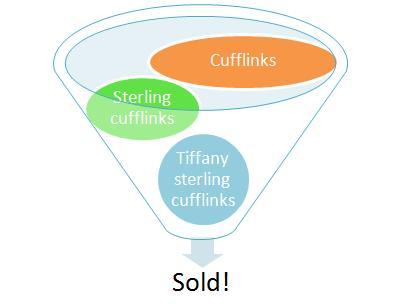As online merchants we all want to attract and retain as many profitable customers as possible at the lowest cost. However, the way we’re marketing ourselves may be getting in the way.
In a recent webinar we discussed a few common pitfalls as they relate to branding, competition, partners, and marketing practices.
What’s “The Conversion Funnel?”
If you haven’t heard the term “conversion funnel” or “marketing funnel,” you’re not alone. It’s a conceptual model that describes the process or phases a customer typically goes through starting with general interest to specific buying intention. It pays to know what the funnel is and how it works because if you can understand where a customer is in the buying cycle you can adjust or optimize your marketing in a manner that increases conversions.

Marketing funnel graphic.
A good example is pay-per-click advertising. A person searching for “cufflinks” is probably farther away from a purchase than a person searching for “Tiffany sterling cufflinks.” Practically speaking, the keyword “cufflinks” will likely result in lots of clicks and virtually no conversions. On the other hand, “Tiffany sterling cufflinks” will result in fewer clicks and more conversions. Which would you prefer, lots of clicks or lots of conversions?
Why and How to Influence Your Brand
Thanks to the rise of social media and interaction with consumers, customers are empowered to actively shape our brands. We create our brands and yet they take on a life of their own.
In the old days we used to try to “manage the message” by broadcasting our brand messages out through various media. Today you can claim your celebrity-inspired cubic zirconia rings look just like the real thing but some consumers will nevertheless say, place like Facebook, that they look like they came out of a bubble gum machine.
So, if you can’t manage the message, what can you do? You can influence your brand by participating actively in your social networks and by making sure your brand positioning matches the brand experience. Actively participate in the discussion because your brand is constantly being shaped with or without your help.
All brands stand for something, but good brands also have trust associated with them. You may not like McDonalds but you can trust the chain to make Big Macs that taste the same regardless of where you buy them. We trust Rolex to convey status and we trust Tide to get our clothes clean.
Partners also influence our brand. This is called “associative branding,” meaning trust by association. You get that by using trust seals intelligently on your website or pairing up with a partner, like Amazon.com, that people trust.
Use Competition to Your Advantage
If you ask small business owners whom they compete with they often say, “We don’t have any competition.” That’s a mistake because every business competes directly or indirectly with others. McDonald’s competes with other hamburger chains but it also competes with other types of fast food restaurants, such as Pizza Hut and Subway.
There’s a lot you can learn from direct and indirect competitors, for free. Pay attention to what works and what doesn’t for them. If they’re running a promotion more than once, it probably worked. What are consumers saying about your competitor’s brand and its product or services? What are consumers complaining about when they talk about your competitors? Rude customer service? Unreliable products? All of these data points are signposts you can use to give you direction. Again, these are only data points but data points you should consider.
If you’re worried about competitors imitating you, consider creating a brand that’s hard to imitate. The reality is, if you’re doing something that is working well, whether it’s product design or marketing messaging, it’s highly likely someone will copy you or will try to copy you. The best defense is to adapt to the circumstances. After all, being agile is absolutely necessary in today’s dynamic business environment.
Approach Partners with Caution
In the webinar, author Karen Leland presented an entire list of questions to ask potential partners before engaging them. The idea is to conduct thorough due diligence so you’re not disappointed down the road. After all, a lot of potential partners may sound good but when you peel the onion you will likely discover not all potential partners are equally a good fit for your business because their philosophy, business practices, or something else just doesn’t align well with your business.
Further, never take what a potential partner says at face value. Talk to customer references and talk to customers who are not references. Check with third parties who certify and monitor business practices and trust.
Set Yourself Up for Success
As small business owners, time is a luxury we don’t have. At the same time it pays to think critically and strategically about the details of our businesses. If we’re not looking out for our own best interests no one will, at least not with the same level of passion that we as business owners and managers do.
Click here to view upcoming and archived Practical eCommerce webinars.>




